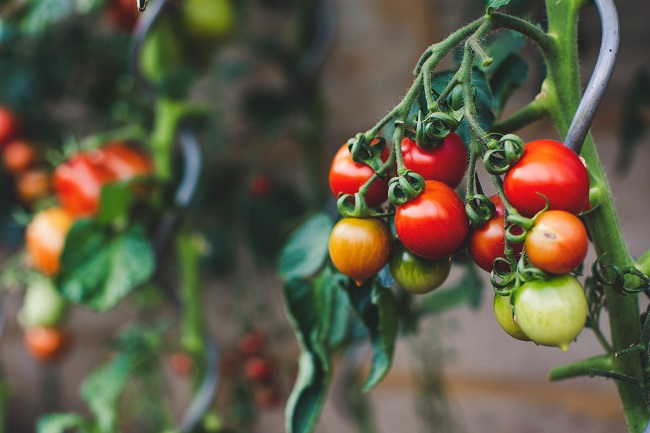
No fruit on your tomato plants is likely due to the weather. Tomatoes thrive in warm, sunny conditions, but temperature extremes can prevent otherwise healthy plants from setting fruit.
When daytime temperatures rise above 90 degrees and night temperatures remain above 70 degrees, blossom drop, and poor fruit development can occur. Combine this with low humidity and the pollen is not viable. In hot and humid conditions, the pollen is too sticky and doesn’t move from the male to the female part of the flower. Without pollination the flowers won’t be fertilized and fruit will not develop.
Cool weather can also hinder fruiting. Night temperatures below the optimum of 59 to 68 degrees reduce the amount and viability of pollen the plant produces.
The simplest solution is to wait for the temperatures and humidity levels to return to those tomatoes need for pollination and fruit formation to occur. Once this happens, the plants will begin producing fruit.
When hot weather arrives, make sure the plants receive ample moisture. Mulch the soil with shredded leaves, evergreen needles or other organic matter to keep roots cool and moist. Consider providing a bit of cool afternoon shade during hot spells.
Some gardeners enlist the help of blossom set hormone spray when conditions are not favorable for pollination and fruit formation. These hormones won’t increase productivity but may help plants set fruit when temperatures are not ideal. These products are most effective when temperatures drop below 60 degrees Fahrenheit. They are less effective at initiating fruit set when temperatures rise over 80 degrees.
Don’t let cooler summer temperatures greatly reduce your tomato harvest. Consider pinching off the growing tips of indeterminate tomatoes a month before the first killing frost. This redirects the plant’s energy into ripening the existing fruit instead of producing more flowers and tomatoes that won’t have time to mature.
When frost is in the forecast, harvest green tomatoes to finish ripening indoors.
Pick any tomatoes that are starting to show color before the killing frost and finish ripening them indoors. Harvest tomatoes when the blossom end turns a greenish white or starts to color up. Store the tomatoes in a cool 60- to 65-degree location to extend their storage life. And don’t let those green tomatoes go to waste. Fry them or use them in salsa and relish. You’ll find lots of delicious green tomato recipes online or from friends.
Extend the growing and harvesting season with the help of floating row covers or other season extending strategies. These products protect plants from cold temperatures, allowing you to harvest weeks after the first fall frost.
If poor fruiting is a yearly problem in your garden, look for tomato varieties better suited to your growing conditions. Next season look for recommendations from your local University extension service. They can help you select the best heat or cold tolerant varieties and those that best fit your gardening style and cooking needs.
With the proper selection and care you will enjoy an abundant harvest in spite of less-than-ideal weather conditions.
Melinda Myers has written more than 20 gardening books, including Small Space Gardening. She hosts the “How to Grow Anything” DVD series and the Melinda’s Garden Moment TV & radio segments. Her website is MelindaMyers.com.
Related Articles & Free Subscription

Dealing with Blossom End Rot in Tomatoes
Winning Tomatoes Add Vibrant Color and Flavor to Gardens and Meals







Comment here